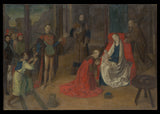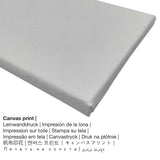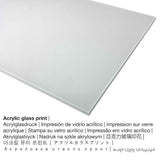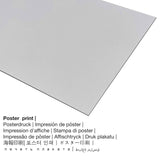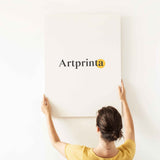Justus nke Ghent, 1465 - Adoration of the Magi - ọmarịcha nka
Ụtụ gụnyere. Mbupu gbakọrọ na ndenye ọpụpụ.
Nkọwa ngwaahịa ebipụta zuru oke
This over 550 year-old work of art "The Adoration of the Magi" was made by the nwoke Onye omenkà Dutch Justus nke Ghent in 1465. Ihe gafere 550 year-old original was painted with the following dimensions of 43 x 63 n'ime (109,2 x 160 cm) ma were ihe osise ese Usoro of distemper on canvas. It belongs to the The Metropolitan Museum of Art's collection, which is one of the world's largest and finest art museums, which includes more than two million works of art spanning five thousand years of world culture, from prehistory to the present and from every part of the globe.. We are pleased to mention that the ngalaba ọha masterpiece na-ọnọ n'ikike nke Ụlọ ihe ngosi nka nke Metropolitan, New York, Arịrịọ nke George Blumenthal, 1941. Ọzọkwa, ọrụ nka nwere kreditline: Arịrịọ nke George Blumenthal, 1941. On top of that, alignment of the digital reproduction is in landscape format and has a side ratio of 1.4 : 1, meaning that ogologo bụ 40% ogologo karịa obosara. The painter Justus of Ghent was a European artist, whose artistic style can mainly be classified as Northern Renaissance. The European painter was born in the year 1460 ma nwụọ mgbe ọ dị afọ 20 n'afọ 1480.
What does the curator team of the The Metropolitan Museum of Art state about this artwork created by Justus of Ghent? (© Nwebiisinka - The Metropolitan Museum of Art - Museumlọ ihe ngosi nka nke Obodo)
Painted in a glue-based medium on canvas, this Adoration of the Magi is by an artist active both in the Netherlands (Ghent) and in Italy (Urbino). Justus shows the youngest king as a black African to indicate that the magi came from the three corners of the world. A black African servant hands him his gift and there is another black African observer in the crowd. Such individuals were increasingly present at the courts of western Europe, but the strikingly similar appearance of these three poses the question of whether they derive from a single model or, instead, were based an idealized type.
Tebụl ihe osise
| Aha nka: | "Ịsọpụrụ ndị Magi" |
| Nhazi: | sere |
| Okwu nche anwụ: | nka ochie |
| Century: | 15th narị afọ |
| Emepụtara n'afọ: | 1465 |
| Afọ nka: | 550 afọ |
| Ọkara nke ihe osise izizi: | distemper na kwaaji |
| Nha izizi: | 43 x 63 n'ime (109,2 x 160 cm) |
| Ụlọ ihe ngosi nka: | Museumlọ ihe ngosi nka nke Obodo |
| Ebe ebe ngosi nka: | New York City, New York, Njikota Obodo Amerika |
| Webụsaịtị ihe ngosi nka: | Museumlọ ihe ngosi nka nke Obodo |
| License: | ngalaba ọha |
| Site n'aka: | Ụlọ ihe ngosi nka nke Metropolitan, New York, Arịrịọ nke George Blumenthal, 1941 |
| Ebe E Si Nweta: | Arịrịọ nke George Blumenthal, 1941 |
Banyere onye na-ese ihe
| Aha onye nka: | Justus nke Ghent |
| Gender: | nwoke |
| Obodo onye nka: | Dutch |
| Ọrụ: | onye na-ese ihe |
| Obodo obibi: | mba netherland |
| Nkewa onye nka: | nna ukwu ochie |
| Ụdị nka: | Northern Renaissance |
| Oge ndu: | 20 afọ |
| Amụrụ n'afọ: | 1460 |
| Nwuru: | 1480 |
Kedu ihe ngwaahịa masịrị gị?
In the dropdown selection next to the article you can select your prefered material and size. Pick your favorite size and material among the following options:
- Mbipụta kanvas: A canvas direct print is a printed canvas mounted on a wood frame. A canvas makes a exclusive effect of three-dimensionality. How do I hang a canvas on my wall? A canvas print has the advantage of being low in weight, meaning that it is easy and straightforward to hang your Canvas print without any wall-mounts. That is why, canvas prints are suited for all types of walls.
- Bipụta akwụkwọ mmado n'ihe kwaaji: Our poster is a UV printed canvas with a fine finish on the surface. It is suited for framing the art copy in a personal frame. Please keep in mind, that depending on the size of the canvas poster print we add a white margin of approximately 2-6cm around the print motif in order to facilitate the framing with your custom frame.
- Aluminom dibond (ọkpụkpụ ọla): An Aluminium Dibond print is a material with an impressive depth effect - for a modern impression and non-reflective surface structure. The bright and white parts of the artwork shimmer with a silk gloss, however without the glare.
- Mbipụta enyo acrylic: A glossy acrylic glass print, often referred to as a print on plexiglass, will transform your favorite artwork into stunning décor and offers a distinct alternative option to dibond and canvas prints. With an acrylic glass fine art print contrasts and minor color details will be exposed thanks to the delicate tonal gradation in the print.
Banyere akụkọ
| Bipụta ụdị ngwaahịa: | nka nka |
| Mmeputakwa: | mmeputakwa n'ụdị dijitalụ |
| Usoro mmepụta: | mbipụta dijitalụ |
| Mmalite nke ngwaahịa a: | German mmepụta |
| Stockdị ngwaahịa: | mmepụta ihe na-achọ |
| Ihe eji eme atụmatụ: | ịchọ mma mgbidi, foto mgbidi |
| Nhazi onyonyo: | nhazi odida obodo |
| Njikwa oyiyi: | 1.4: 1 |
| Akụkụ akụkụ pụtara: | ogologo bụ 40% ogologo karịa obosara |
| Akwa ngwaahịa dị: | ígwè ebipụta (aluminium dibond), acrylic glass print (nwere ezigbo mkpuchi iko), mbipụta akwa akwa, mbipụta akwụkwọ mmado (akwụkwọ kwaaji) |
| Nha n'arọwa n'elu ihe ndọtị (mbipụta akwa akwa): | 70x50cm - 28x20", 140x100cm - 55x39" |
| Mbipụta iko acrylic (nwere ezigbo mkpuchi iko) nhọrọ nha: | 70x50cm - 28x20", 140x100cm - 55x39" |
| Mpempe akwụkwọ mmado (akwụkwọ kwaaji) nha: | 70x50cm - 28x20" |
| Mbipụta aluminom: | 70x50cm - 28x20", 140x100cm - 55x39" |
| Nhazi mmeputa nka nka: | biko mara na mmeputakwa a enweghi etiti |
Legal disclaimer: We try what we can to depict our products as accurately as possible and to display them visually. However, the tone of the print products and the print result can differ marginally from the representation on your device's screen. Depending on your settings of your screen and the nature of the surface, colors might not be printed as exactly as the digital version shown here. Considering that our art prints are printed and processed by hand, there might also be slight discrepancies in the exact position and the size of the motif.
© echebe nwebiisinka - Artprinta.com (Artprinta)

